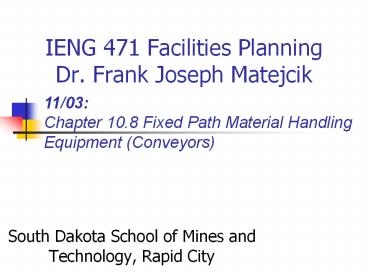IENG%20471%20Facilities%20Planning%20Dr.%20Frank%20Joseph%20Matejcik - PowerPoint PPT Presentation
Title:
IENG%20471%20Facilities%20Planning%20Dr.%20Frank%20Joseph%20Matejcik
Description:
towline and trolley-type conveyors. AGVs. Computer Dispathed Lift Trucks ... Towline or Trolley Conveyors. Called conveyor analysis: ... – PowerPoint PPT presentation
Number of Views:106
Avg rating:3.0/5.0
Title: IENG%20471%20Facilities%20Planning%20Dr.%20Frank%20Joseph%20Matejcik
1
IENG 471 Facilities Planning Dr. Frank Joseph
Matejcik
11/03 Chapter 10.8 Fixed Path Material Handling
Equipment (Conveyors)
- South Dakota School of Mines and Technology,
Rapid City
2
Section Intro
- Widely used
- Types
- powered belt and roller conveyors
- towline and trolley-type conveyors
- AGVs
- Computer Dispathed Lift Trucks
3
Towline or Trolley Conveyors
- Called conveyor analysisanalysis of
closed-loop, irreversible, or recirculating
conveyors with discretely spaced containers.
4
Towline or Trolley ConveyorsOperating Problems
- 1. At a loading station, no empty carriers were
available when a loading operation was to be
performed. - 2. At an unloading station, no loaded carriers
were available when an unloading operation was to
be performed.
5
Kwos Principles for closed-loop irreversible
Conveyors
- 1. Uniformity principle Materials should be
uniformly distributed over the conveyor. - 2. Capacity principle The carrying capacity of
the conveyor must be greater than or equal to the
system throughput requirements.
6
Kwos Principles for closed-loop irreversible
Conveyors
- 3. Speed principle The speed of the conveyor (in
terms of the number of carriers per unit time)
must be within the permissible range, defined by
loading and unloading station requirements and
the technological capability of the conveyor. - Also, Kwo found sufficient conditions for
steady-state operations
7
Muth defintions
- s is number of stations
- k is number of carriers
- The amount of material loaded on carrier n as it
passes station i is given by fi(n) for i 1, 2,
s - The amount of material carried by carrier n
afterit passes station i is given by Hi(n) for i
1, 2, s
8
Muth formulas
- p is the period. We assume f is periodic
- F is a convenience term.
9
Muth results
- 1. k/p cannot be an integer for steady-state
operations. - 2. Letting r k mod p, r/p must be a proper
fraction for general sequences F1(n) to be
accommodated. - 3. It is desirable for p to be a prime number, as
conveyor compatibility results for all admissible
values of k
10
Approach to find Hi (n)
11
Approach to find Hi (n)
12
Example 10.30
13
Example 10.30
14
Example 10.30
15
Example 10.30
16
Example 10.30
17
Example 10.30
18
Example 10.30
19
Example 10.30
20
Example 10.301
- As a design choice we may try to alter the value
of k. - The results may not be obvious increasing k does
not always decrease the value of B. - Also, as a design choice we may be able to change
the value of s.
21
Example 10.30 Alternative k s
22
Example 10.30 Alternative k s
23
Examples 10.31 10.32 comments
- Example 10.31 shows that reordering of the fi(n)
sequences can reduce the value of B. This is a
possible design decision. - Example 10.32 exchanging positions even when s
3 can reduce B.
24
Horsepower Requirements
- HP horsepower requirement
- S speed of conveyor (fpm)
- L load to be carried (lbs)
- TL total length of conveyor (ft)
- RC spacing between center lines of rollers
- WBR width between rails (belt width 2.5)
- a angle of incline
- LLt live load in incline (lbs)
- BV base value
- FF Friction Factor (roller.05, slide bed0.3)
- LF Length Factor
25
Horsepower Requirements
This formula is applied in a direct manner for
many of the calculations. Tables and comments
supply many of the unusual values. Bulk conveyors
are more simple. Just use tables and do a
summary calculation.
26
Belt Conveyors
- BV approx. (2/3) WBR
- FF 0.05 roller, 0.30 bed supported
27
Roller Conveyors
- FF 0.10 to 0.05 based on drive type
- BV 4.60 0.445(WBR)
28
Bulk Belt Conveyors
- Speed given belt width is limited
29
Bulk Belt Conveyors
- Table 10.14 gives max. angle of incline
- Table 10.15 gives Delivered Capacity
- Table 10.16 HP of empty conveyor
- Table 10.17 HP of horizontal delivery
- Table 10.18 HP for lifting material
- Overall HP 1.2(Sum 3 tables above)
30
Flow Path Design Models
- Conventional Flows
- Tandem Flows
- Deciding between the two is beyond the scope of
the text.
31
Conventional FlowAnalytical Model
- Decide direction of flow
- generally unidirectional or bidirectional
- This model unidirectional
- Kaspi Tanchoco node arc network
- Nodes pickup station, delivery station, and
aisle intersections - Arcs flow paths between nodes
32
Analytical Model Variables
33
Analytical Model Objective
34
Analytical Model Constraints
35
Analytical Model Constraints
36
Analytical Model
- Too large a model (too many variables) for
practical situations - branch bound method can give feasible solutions
in reasonable times
37
Branch and Bound Approach
Tandem Flow Systems
- Skipped for our class































